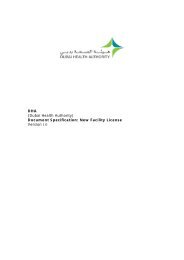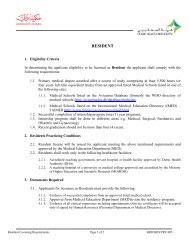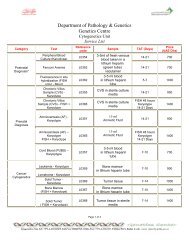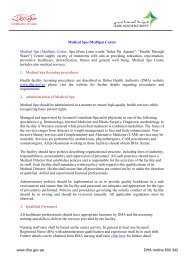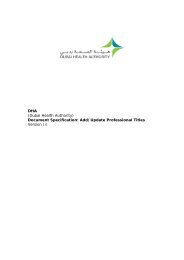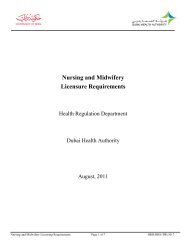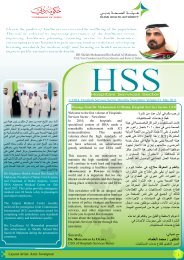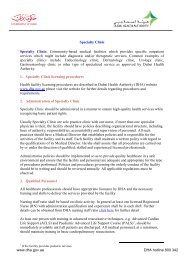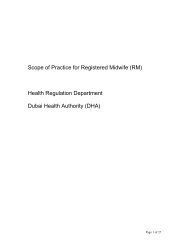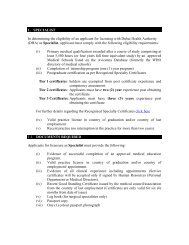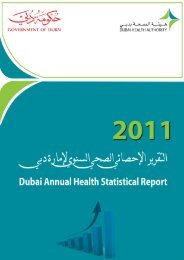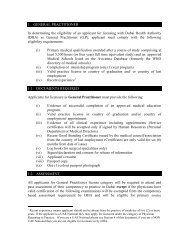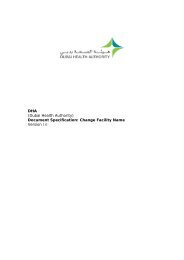Health Record Guidelines - Dubai Health Authority
Health Record Guidelines - Dubai Health Authority
Health Record Guidelines - Dubai Health Authority
- No tags were found...
Create successful ePaper yourself
Turn your PDF publications into a flip-book with our unique Google optimized e-Paper software.
<strong>Health</strong> Regulation Department<strong>Health</strong> <strong>Record</strong><strong>Guidelines</strong>2012
Table of ContentsAcknowledgment 31. Scope 42. Purpose 43. Definitions 44. Acronyms 6SECTION ONE: GENERAL REQUIRMENTS 71. Facility <strong>Record</strong> Keeping Requirements 72. <strong>Health</strong> <strong>Record</strong> Contents and Electronic Format 73. Telephone or Verbal Orders 74. Methods of Documentation 8SECTION TWO: SPECIFIC HEALTH RECORDS REQUIRMENTS 95. <strong>Health</strong> <strong>Record</strong>s Contents 96. Informed Consent 107. In Patient <strong>Health</strong> <strong>Record</strong>s Contents 108. Surgical Contents 119. Medical Contents 1110. Nursing <strong>Record</strong>s 1111. Obstetric Content 1212. Newborn Content 1313. Discharge Summary 1314. Patient Access and Release of Patient Information 1315. <strong>Record</strong>s Detail with Negative Impact 1416. Emergency <strong>Record</strong> 1417. <strong>Record</strong> completion 1418. Changes, Corrections, or Other Modifications in <strong>Health</strong> <strong>Record</strong> 1419. Retention of <strong>Health</strong> records 1520. Destruction of <strong>Health</strong> records 1521. Compliance with these guidelines: 16References 17<strong>Health</strong> <strong>Record</strong> <strong>Guidelines</strong> Page 2 of 17 Ref. No. HRD/HRS/FRU010
AcknowledgmentMany individuals have assisted the <strong>Health</strong> Regulation Department in <strong>Dubai</strong> <strong>Health</strong> <strong>Authority</strong>(DHA) and contributed to the development and review of this guideline. Their contributions havebeen invaluable. The <strong>Health</strong> Regulation Department would like to gratefully acknowledge thosepeople and to thank them for their dedication to quality in health and their assistance in undertakingsuch a complex task.Editor of the Second EditionDr. Mhd. Oussama Kayali, MBBS, MBAHead of <strong>Health</strong> Regulation Section<strong>Dubai</strong> <strong>Health</strong> <strong>Authority</strong>Linda Abdullah Ruhi, MSc(QM), BSc (MT)Quality and Accreditation Officer<strong>Health</strong> Regulation DepartmentDr. Layla Mohamed AlMarzouqi MBBS,Head of Clinical Governance Office<strong>Dubai</strong> <strong>Health</strong> <strong>Authority</strong><strong>Health</strong> <strong>Record</strong> <strong>Guidelines</strong> Page 3 of 17 Ref. No. HRD/HRS/FRU010
Next of Kin: The person who is authorized to make decision on behalf of the patient (In case of thepatient is un-conscious, minor or mentally ill), Next of Kin may include: Father, Mother, Adultsons – daughters or brothers / spouse / Legal guardian or the sponsor (if next of kin as per the abovementioned level is not available, then relatives available from the same origin of the spouse's sidewill be considered as a next of kin). 1Minor: any person from the birth to the age of 18 years.1 For further information regarding Next of Kin, Minor please see the Civil Federal Law number 5 for the year of 1985and the Civil Federal Law number 1 for the year of 1987<strong>Health</strong> <strong>Record</strong> <strong>Guidelines</strong> Page 5 of 17 Ref. No. HRD/HRS/FRU010
4. AcronymsDHA : <strong>Dubai</strong> <strong>Health</strong> <strong>Authority</strong>HRD : <strong>Health</strong> Regulation DepartmentCGO : Clinical Governance OfficeDAMA : Discharge Against Medical AdviceHRD : <strong>Health</strong> Regulation DepartmentICU : Intensive Care Unit<strong>Health</strong> <strong>Record</strong> <strong>Guidelines</strong> Page 6 of 17 Ref. No. HRD/HRS/FRU010
SECTION ONE: GENERAL REQUIRMENTSThe health record is a legal document that should accurately outline the total needs, care andmanagement of patients. It facilitates communication, decision making and evaluation of care inaddition to protecting the legal interests of the patient, healthcare professionals and the healthfacility.1. Facility <strong>Record</strong> Keeping Requirements1.1 A legible, complete, comprehensive, and accurate health record must be maintained for eachpatient. Each health facility must maintain records and reports in a manner to ensure accuracyand easy retrieval.1.2 Each healthcare facility shall provide health record storage room or other suitable healthrecord keeping area with adequate supplies and equipment.1.3 <strong>Health</strong> records should be stored safely to provide protection from loss, damage, andunauthorized use.1.4 <strong>Health</strong> records shall be maintained in the custody of the health facility and shall be availableto a patient or his/her designated representative through the attending healthcare professionalor his/her designated representative at reasonable times and upon reasonable notice.2. <strong>Health</strong> <strong>Record</strong> Contents and Electronic Format2.1 <strong>Health</strong> <strong>Record</strong>s must be maintained for every patient, including newborn infants, admitted forcare in the hospital or treated in the emergency or outpatient services.2.2 <strong>Health</strong> records may be created and maintained in written paper base or electronic format, or acombination of both, and must contain sufficient information to clearly identify the patient, tojustify the diagnosis and treatment and to document the results accurately.2.3 <strong>Health</strong> records must contain entries which are dated, legible and indelibly verified. The authorof each entry must be identified and authenticated. Authentication must include: officialstamp, signature, written initials, or computer entry.3. Telephone or Verbal Orders3.1 The most error-prone communications are patient care orders given verbally and those givenover the telephone. The health facility shall implement clinical protocols which minimize theuse of verbal and telephone orders3.2 Telephone or verbal communications by an authorized healthcare professional such as reportback of clinical laboratory critical tests results are accepted and shall be transcribed by aqualified healthcare professional.3.3 The health facility shall develop a policy and/or procedures that address the accuracy ofverbal and telephone communications. The policy must specify the situations when verbal andtelephone orders are accepted.3.4 Telephone or verbal communications must be documented immediately by the healthcareprofessional that receives the order and should be authenticated within 24 hours by thehealthcare professional that is responsible for ordering or evaluating the service furnished<strong>Health</strong> <strong>Record</strong> <strong>Guidelines</strong> Page 7 of 17 Ref. No. HRD/HRS/FRU010
4. Methods of Documentation4.1 All healthcare professionals should document their notes in the health records byadopting an appropriate method of documentation. This will facilitate communicationbetween various healthcare professionals, health facilities and DHA.4.2 Assessment findings should be documented in a uniform manner and uniform locationin the patient’s health record.4.3 An example of a popular documentation method is SOAP. The four parts of a SOAPnote include:4.3.1 SUBJECTIVE: The “S” portion of the SOAP note documentation format consistsof subjective observations. These are the recordings of the symptoms that the patientverbally expresses or as stated by someone speaking for the patient. These subjectiveobservations include the patient's descriptions of pain or discomfort, the presence of nauseaor dizziness and a multitude of other descriptions of dysfunction, discomfort or illness thatthe patient describes.4.3.2 OBJECTIVE: “O” is for the objective observation. These objective observationsinclude symptoms that can actually be measured, seen, heard, touched, or felt. Theseinclude but not limited to the patients’ vital signs such as temperature, pulse, respiration,swelling and the results of diagnostic tests.4.3.3 ASSESSMENT: “A” is for assessment and follows the objective observations.Assessment is the diagnosis of the patient's condition. In some cases the diagnosis may beclear, such as a contusion. However, an assessment may not be clear and could includeseveral diagnosis possibilities.4.3.4 PLAN - The last part of the SOAP note, “P”, is the plan. The plan may includeordered medications, laboratory and/or radiology tests, treatments, patient referrals (sendingpatient to a specialist), patient disposition (e.g., home care, bed rest, short-term, long-termdisability, days excused from work, admission to hospital), patient directions and follow-updirections for the patient<strong>Health</strong> <strong>Record</strong> <strong>Guidelines</strong> Page 8 of 17 Ref. No. HRD/HRS/FRU010
SECTION TWO: SPECIFIC HEALTH RECORDS REQUIRMENTS5. <strong>Health</strong> <strong>Record</strong>s Contents5.1 Each patient health record must contain at least (but not limited to) the following information(where applicable):5.1.1 Identification data5.1.2 A unique identifier for health records5.1.3 A system to alert staff to patients of the same name5.1.4 Time and date of seeing the patient5.1.5 Full Patient History which includes but not limited to: (Chief complaint, Present illness,Social and psychological review, Medication Allergies, Family History of illnesses,Present complaint and Previous complaints, Past medical history)5.1.6 Physical examination and system review5.1.7 Admission diagnosis5.1.8 All pathology/laboratory and radiology reports5.1.9 Properly executed informed consent forms5.1.10 Physicians orders5.1.11 Pain assessment5.1.12 Documentation of all care and treatment, medical and surgical, signed and stamped byattending physician5.1.13 Histopathology and tissue reports5.1.14 Progress notes of all disciplines5.1.15 Discharge summary5.1.16 Discharge card: must be given to the patient on discharge without charge.5.1.17 Autopsy findings; and death certificate5.1.18 Advanced Directives (if available)5.1.19 Patient education5.1.20 Vaccination records (for paediatric patients)5.1.21 Police care clearance.5.2 When a patient has been advised to seek additional care for further assessment, treatment, andfollow-up; the patient’s health record will contain documentation of the given advice.5.3 Assessment findings shall be integrated and documented in the patient’s health record andreadily available to those responsible for the patient’s care.5.4 Relevant findings from assessments performed outside the health facility should be includedin the patient assessment process and health record.5.5 The organization defines the process for obtaining and using outside assessment findings andreports.<strong>Health</strong> <strong>Record</strong> <strong>Guidelines</strong> Page 9 of 17 Ref. No. HRD/HRS/FRU010
6. Informed Consent6.1 As per article (7) of the Federal Law number 10/2008 concerning Medical Liability and theCabinet Decision No. (33) of 2009 promulgating the bylaw of the medical liability lawInformed consent shall be obtained by the treating physician from the patient or hisDesignated representative (as applicable) and after a discussion of the complication, risks,benefits and alternatives of procedures/surgeries (excluding emergency cases).6.2 If the patients lack the full capacity (e.g. less than 18 years old) informed consent shall betaken from their relatives up to the fourth degree, before the procedure/surgery isperformed.6.3 Consent documentation shall be maintained in the patient's health record.6.4 Patients shall be provided with comprehensive and accessible information concerningtreatment/procedure and alternatives.6.5 The health facility shall clearly define investigations, treatment and procedures that requirepatient consent.6.6 The health facility must develop an internal consent policy and procedures that areconsistent with the federal legislation including procedures for individuals lacking thecapacity of making informed decisions.6.7 All consents should comply with the Federal Law number 10/2008 concerning MedicalLiability. Click here for further details regarding this law and informed consentrequirements or visit the <strong>Health</strong> Regulation on DHA website www.dha.gov.ae .6.8 <strong>Health</strong>care professionals working in the health facility shall be educated about the consentpolicy.6.9 Where consent is obtained by the visiting community physician, the health facilitymanagement shall ensure that the signed consent is received and filed in the patient healthrecord.7. In Patient <strong>Health</strong> <strong>Record</strong>s Contents7.1 Specific in-patient health record contents are applicable only to health facilities providingin-patient care such as hospitals and Day Surgical Centre setting.7.2 Admission and Discharge <strong>Record</strong> may include but not limited to the following:7.1.1 Date and time of admission and discharge7.1.2 Adequate identification - sociological data (including hospital number assigned topatient)7.1.3 Admission diagnosis7.1.4 Final diagnosis, secondary diagnosis and any complications7.1.5 Operative procedures and complications during surgery (if any) and any other relativeinformation such as amount of blood loss during operation, etc.7.1.6 Condition on discharge7.1.7 Signature and official stamp of attending physician.<strong>Health</strong> <strong>Record</strong> <strong>Guidelines</strong> Page 10 of 17 Ref. No. HRD/HRS/FRU010
8. Surgical Contents8.1 In addition to the requirements of patient health records; all health records of patientsundergoing surgery shall include (but not limited to) the following:8.1.1 Date and time of admission and discharge8.1.2 History, physical, special examinations, and diagnosis recorded prior to operation8.1.3 Identification of correct site of surgery8.1.4 Anaesthesia record, including post-anaesthetic condition signed and stamped by theanaesthesiologist, or surgeon8.1.5 Complete description of operative procedures and findings including post-operativediagnosis recorded and signed and stamped by the attending surgeon promptlyfollowing the operation.8.1.6 The histopathologist's report on all tissues removed at the operation.8.1.7 A signed consent form by the patient or his Designated representative8.1.8 Admission diagnosis, Final diagnosis, secondary diagnosis and any complications8.1.9 Signature and official stamp of attending physician.9. Medical Contents9.1 Plan of care.9.2 Reports of consultation by consulting physicians, when applicable.9.3 Signed permission for surgery, anaesthesia, autopsy, and other procedures when necessary10. Nursing <strong>Record</strong>s10.1 Basic Nursing Forms (mandatory) should include (but not limited to):10.1.1 Initial Nursing Assessment Form10.1.2 Nursing Care Plan10.1.3 Nurses Notes Form (progress notes)10.1.4 Temperature, Pulse, Respiration and Blood Pressure Chart10.1.5 Paediatric Observation Chart (if applicable)10.1.6 24 Hour Nursing Report10.1.7 Medication Chart10.1.8 Pain Documentation10.1.9 Patient/family education10.2 Special Nursing forms (when applicable ) should include (but not limited to):10.2.1 Special Observation Chart10.2.2 Pre operative checklist10.2.3 Labor record10.2.4 Weight Chart<strong>Health</strong> <strong>Record</strong> <strong>Guidelines</strong> Page 11 of 17 Ref. No. HRD/HRS/FRU010
10.2.5 Fluid Balance Chart10.2.6 Diabetic Chart10.2.7 Newborn identification form10.2.8 Nursing assessment of the newborn in SBCU(special baby care unit)10.2.9 ICU (intensive care unit) Chart10.2.10 Infection chart10.2.11 MICU(medical ICU) / PICU(pediatric ICU) flow chart10.2.12 NICU(neonatal ICU) chart10.2.13 Neonatal intensive care unit / IV fluid intake / output chart10.2.14 Feeding chart10.2.15 Investigation flow sheet10.2.16 Partial exchange transfusion chart10.2.17 Paediatric peritoneal dialysis10.2.18 Anticoagulant drug chart10.2.19 Conscious sedation10.2.20 Haemodialysis profile10.2.21 Manual peritoneal dialysis chart10.2.22 Diabetic ketoacidosis chart10.2.23 Out and pass forms10.2.24 Transfer slips11. Obstetric Content11.1 In addition to the requirements of health records, records of all obstetric patients shallinclude (but not limited to) the following:11.1.1 <strong>Record</strong> of previous obstetric history and pre-natal care including blood serology, andRhesus factor determination (Rh).11.1.2 Admission obstetric examination report describing condition of mother and fetusincluding ultrasound report or any other related tests.11.1.3 Complete description of progress of labor and delivery, including reasons forinduction and operative procedures.11.1.4 <strong>Record</strong>s of anaesthesia, analgesia, and medications given during the course of laborand delivery11.1.5 Cardiotocography <strong>Record</strong>s (CTG) of contraction and fetal heart rate records.11.1.6 Signed reports of consultants when such services have been obtained.11.1.7 Progress notes including description of involution of uterus, type of lochia,condition of breast and nipples, and report of condition of infant following delivery11.1.8 Names of assistants/midwives present during delivery<strong>Health</strong> <strong>Record</strong> <strong>Guidelines</strong> Page 12 of 17 Ref. No. HRD/HRS/FRU010
12. Newborn Content12.1 <strong>Record</strong>s of newborn infants shall be maintained as separate records and shall contain(but not limited to) the following information:12.1.1 Date and time of birth, birth weight and length, period of gestation, sex, Apgarscore.12.1.2 Parents’ names and addresses.12.1.3 Type of identification placed on the infant in the delivery room.12.1.4 Description of complications during pregnancy or delivery which includes (but notlimited to) premature rupture of membranes; condition at birth including colour,quality of cry, method and duration of resuscitation.12.1.5 <strong>Record</strong> of prophylactic instillation into each eye at delivery.12.1.6 Results of Phenyl Keto Urea (PKU) tests.12.1.7 Report of initial physical examination, including any abnormalities, signed by theattending physician.12.1.8 Progress notes including temperature, weight, and feeding charts; number,consistency, and colour of stools; condition of eyes and umbilical cord; condition andcolour of skin; and motor behaviour.13. Discharge Summary13.1 Each healthcare facility must provide a discharge summary/card to the patient upondischarge, which should include (but not limited to) the following details:13.1.1 Date and time of admission and discharge13.1.2 Adequate identification (including record number assigned to patient)13.1.3 Admission diagnosis13.1.4 Final diagnosis, secondary diagnosis, complications13.1.5 Operative procedures (if applicable)13.1.6 Condition on discharge with medication13.1.7 Follow up plan13.1.8 Signature and official stamp of attending physician14. Patient Access and Release of Patient Information14.1 <strong>Health</strong> records can only be accessed by the patient himself or designated representative andunder supervision of attending physician or the most responsible healthcare professional.14.2 The patient or designated representative has the right to request his/her information throughrequesting medical reports, or a copy of the previous reports14.3 No fees shall be charged by a healthcare professional for health records request receivedfrom another healthcare professional solely for the purpose of providing continuing medicalcare to the patient.<strong>Health</strong> <strong>Record</strong> <strong>Guidelines</strong> Page 13 of 17 Ref. No. HRD/HRS/FRU010
14.4 The health facility may supply a written interpretation by the attending healthcareprofessional or his/her designated representative of records, such as x-rays, which cannot bereproduced without special equipment. If the requestor prefers to obtain a copy of suchrecords, he/she must pay the actual cost of such reproduction.15. <strong>Record</strong>s Detail with Negative Impact15.1 It is the attending healthcare professional's responsibility to flag a patient's record denotingthat any or all portions may contain information that has significant negativepsychological impact upon the patient and that the information recorded should not bereleased to the patient and/or designated representative without the consent and knowledgeof the attending healthcare professional.15.2 It is the attending healthcare professional's responsibility to flag a patient's record denotingany medication allergies, or any special information/needs like HIV, Hepatitis, blindness,etc.16. Emergency <strong>Record</strong>16.1 Copies of <strong>Health</strong> records in the custody of emergency rooms of facility shall be available topatients or their designated representatives as detailed in previous paragraph.17. <strong>Record</strong> completion17.1 Time frames shall be established for completing histories, physical and psychosocialexaminations, discipline-specific assessments and when appropriate, reassessments. Timeframes for initial assessments and reassessments may differ according to setting, unit,service (such as surgery, dental, etc), and patient acuity.17.2 Assessment findings should be integrated and documented in the patient’s record andreadily available to those responsible for the patient’s care17.3 All orders for diagnostic procedures, treatments, and medications shall be signed andstamped by the physician submitting them and entered in the patient record in ink or in type.The prompt completion of a patient record shall be the responsibility of the attendingphysician.17.4 Rubber stamp shall include physician name, speciality and license number17.5 Authentication maybe by written signature and stamp, identifiable initials or computer key.The use of stamp signatures is acceptable under the following conditions:17.5.1 If the physician using the rubber stamp signature is the only person authorized thepossession of the stamp and is the only one who may use it.17.5.2 The physician places in the administrative office of the hospital a signed statement tothe effect that he is the only one who has the stamp and is the only one who uses it.17.5.3 Initials should never be used to authenticate assessments or narrative documentation;therefore initials should be avoided elsewhere because of difficulty in identifyingauthor, i.e. two persons with same initials.18. Changes, Corrections, or Other Modifications in <strong>Health</strong> <strong>Record</strong>18.1 If any changes, corrections, or other modifications are made to any portion of the patient’srecord, the healthcare professional must note in the record the date, time, nature, reason,<strong>Health</strong> <strong>Record</strong> <strong>Guidelines</strong> Page 14 of 17 Ref. No. HRD/HRS/FRU010
correction, or other modification in addition to his/her name and the name of a witness to:the change, correction, or other modification done unto the health record.18.2 The use of correctors is not permissible such as (white ink) or any form of erasable pens.18.3 Electronic form of health records should have that ability to trace any change, or othermodifications in the record with identification of the person who did the change ormodification.18.4 Any change in the documentation or patient information done on purpose and withoutproper documentation will be considered unethical and shall bear legal consequences.19. Retention of <strong>Health</strong> records19.1 In patient health facilities such as hospital and Day Surgical centres, <strong>Health</strong> InformationStaff/Unit/Section shall be responsible for the retention of patient health records, data andinformation.19.2 In Ambulatory care setting and diagnostic centres the medical director shall be responsibleperson for the retention of patient health records, data and information.19.3 <strong>Health</strong> <strong>Record</strong>s of UAE national patients must be retained the up to 10 years after the mostrecent patient visit/admission to the health facility.19.4 <strong>Health</strong> <strong>Record</strong>s for expatriate patients must be retained the up to 5 years after the mostrecent patient visit/admission to the health facility.19.5 The health care facilities should retain the following records in the original form for theperiod specified:19.5.1 The health records of medico-legal cases up to 20 years, such records then maybeentered into the Image Processing System and destroyed.19.5.2 Files of deceased patients to be stored for 5 years, such records then maybe enteredinto the Image Processing System and destroyed.19.5.3 The patient health records of certain major diseases and incidents selected by theadministrations and requested by the consultants for academic, research andadministrative purposes may be retained for longer periods than specified.19.5.4 Dental records need to be stored for 10 years for both UAE nationals and expatriatepatients after the most recent patient visit/admission to the health facility.20. Destruction of <strong>Health</strong> records20.1 The health facility shall establish procedures for notification of patients whose healthrecords are to be destroyed prior to their destruction.20.2 The sole responsibility for the destruction of all health records shall be in the facilityinvolved, legal consultant may be consulted prior to records destruction.20.3 <strong>Health</strong> records may be destroyed only when they are in excess of the retention requirementsspecified in the previous paragraph.20.4 In order to ensure the patient's right of confidentiality, health records are destroyed ordisposed of by shredding, incineration, electronic deletion, or another equally effectiveprotective measure<strong>Health</strong> <strong>Record</strong> <strong>Guidelines</strong> Page 15 of 17 Ref. No. HRD/HRS/FRU010
21. Compliance with these guidelines:21.1 HRD has full authority to request the original health records if needed to be returned to thehealth facility.21.2 <strong>Health</strong> facilities licensed by the DHA shall comply with the <strong>Health</strong> <strong>Record</strong>s guidelines.21.3 Periodic visits will be conducted by HRD inspection team to ensure compliance with theguidelines.<strong>Health</strong> <strong>Record</strong> <strong>Guidelines</strong> Page 16 of 17 Ref. No. HRD/HRS/FRU010
ReferencesUAE Federal Law number 2/1996 concerning Private <strong>Health</strong> FacilitiesUAE Federal Law number 10/2008 concerning Medical LiabilityThe Cabinet Decision number (33) of 2009 promulgating the bylaw of the medical liability law.UAE Federal Law number 11/2008 concerning Licensing Fertility Centers.DHA Private <strong>Health</strong>care StandardsJoint Commission International Accreditation Standards for HospitalEQuIP for Day Surgical Hospital Standards and guidelines of the Australian Council on <strong>Health</strong>careStandard – ACHSThe National Hospital Standards of the Central Board of Accreditation for <strong>Health</strong> Institutions(CBAHI), Kingdom of Saudi Arabia.<strong>Health</strong> <strong>Record</strong> <strong>Guidelines</strong> Page 17 of 17 Ref. No. HRD/HRS/FRU010



